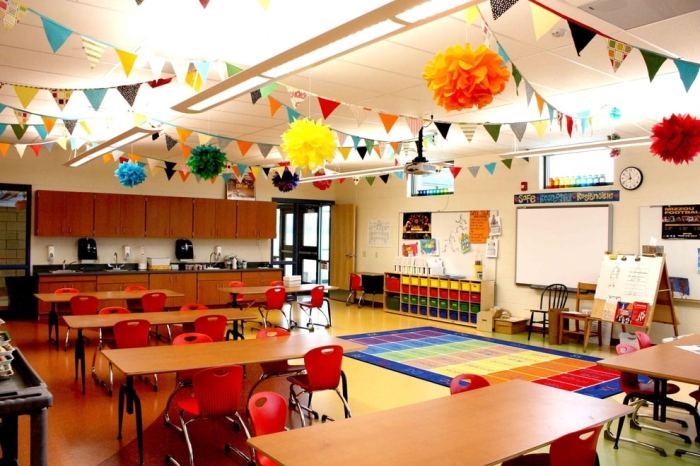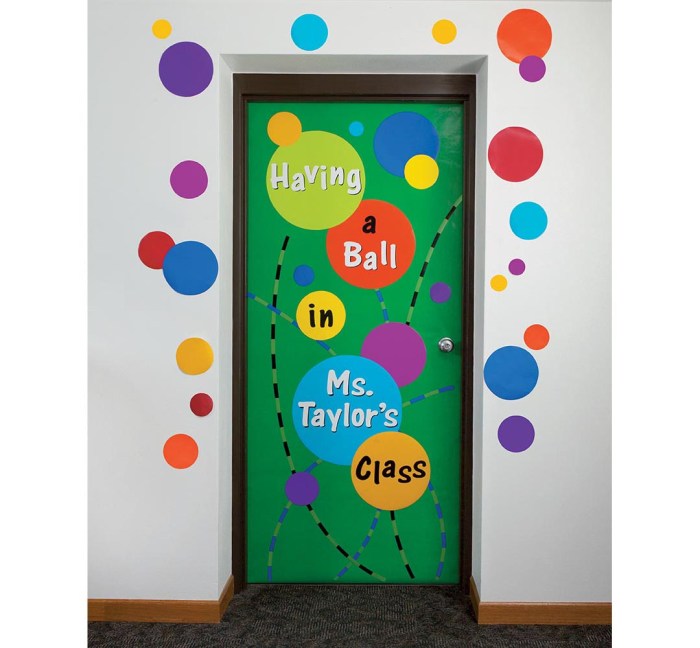Gloves For Classroom Decoration: Transform ordinary gloves into extraordinary classroom décor! This guide explores the surprising versatility of gloves, showcasing creative ways to upcycle them into engaging and thematic classroom decorations. From whimsical puppets and vibrant flowers to intricate three-dimensional art installations, we’ll delve into diverse techniques and designs suitable for various grade levels and subjects. Discover how to select appropriate materials, prioritize safety, and create a visually stimulating learning environment that sparks creativity and imagination.
We’ll cover various glove types, their pros and cons, and detailed crafting instructions, ensuring a comprehensive resource for teachers and educators seeking unique and cost-effective classroom enhancements. Learn how to tailor your glove decorations to specific themes, subjects, and learning environments, maximizing their educational impact and aesthetic appeal. Prepare to unleash your inner artist and transform your classroom into a captivating space with the help of this surprisingly versatile craft material.
Thematic Glove Decorations for Different Classrooms: Gloves For Classroom Decoration

Transforming ordinary gloves into engaging classroom decorations offers a unique and cost-effective way to enhance the learning environment. The versatility of gloves allows for creative adaptations across various grade levels and subject areas, fostering a more stimulating and thematic classroom experience. Careful consideration of age appropriateness and subject matter is key to maximizing the educational impact of these decorations.
Glove Decorations by Grade Level
Appropriate glove decorations should cater to the developmental stages and interests of students in different grade levels. Preschool classrooms can benefit from brightly colored gloves transformed into playful animals or simple characters, stimulating imagination and encouraging tactile exploration. Elementary school classrooms might feature gloves crafted into storybook characters or objects related to current learning units, reinforcing concepts through visual aids.
Middle school classrooms could incorporate more complex designs, perhaps representing historical figures or scientific instruments, engaging students with abstract concepts. High school classrooms could use gloves to create sophisticated art installations or models relevant to specific subjects, promoting critical thinking and creative expression. The level of complexity and detail should progressively increase with the students’ age and cognitive abilities.
Themed Glove Decorations by Subject
Gloves can be effectively utilized to create themed decorations across various subjects. For science classrooms, gloves can be transformed into models of cells, molecules, or even miniature lab equipment. In history classes, gloves can depict historical figures or artifacts, bringing the past to life. Literature classes can utilize gloves to represent literary characters, settings, or symbols from novels and plays.
Art classes can use gloves as the base for three-dimensional art projects, incorporating diverse materials and techniques. This thematic approach seamlessly integrates decorations with the curriculum, enriching the learning experience.
Glove Decorations in Different Learning Environments
The application of glove decorations varies significantly depending on the classroom’s function. In an art classroom, gloves can be incorporated into mixed-media projects, becoming part of larger art installations or sculptures. They could be painted, embellished with fabric scraps, or used as forms for creating unique three-dimensional pieces. In a science lab, gloves might be used to represent scientific apparatus or models of biological structures, serving as both decorative elements and learning aids.
In a library setting, gloves could be transformed into book characters or whimsical creatures, creating a welcoming and imaginative atmosphere that encourages reading. The use of gloves should complement and enhance the overall aesthetic and function of each learning environment.
Practical Considerations and Safety

Creating engaging classroom decorations with gloves is a fun and creative activity, but prioritizing safety and responsible material selection is paramount, especially when working with younger children. The potential for accidental ingestion or allergic reactions necessitates careful consideration of the materials used and the implementation of appropriate safety measures throughout the process.The use of non-toxic and hypoallergenic materials is crucial for minimizing health risks.
Gloves intended for decoration should be thoroughly inspected for any potential hazards before use. Furthermore, maintaining cleanliness and hygiene throughout the project and its display is essential for a healthy classroom environment.
Material Selection and Toxicity
Choosing safe materials is the cornerstone of responsible classroom decoration. Avoid gloves made from materials containing known toxins or allergens. Latex gloves, for example, are a common allergen and should be avoided in classrooms where students might have latex sensitivities. Opt for gloves made from non-toxic materials such as vinyl or nitrile, ensuring they are clearly labeled as suitable for crafting or decorative purposes.
When in doubt, always prioritize materials specifically designed for children’s crafts. The manufacturer’s information should clearly state the material’s safety and suitability for use in educational settings. Prioritize materials with certifications indicating compliance with relevant safety standards.
Safety Precautions During Glove Handling and Disposal
Proper handling and disposal of gloves are essential safety procedures. Supervise children closely during all stages of the crafting process, ensuring they do not put gloves in their mouths or handle them in a way that could lead to injury. Sharp objects should be avoided when working with the gloves to prevent accidental punctures. After use, gloves should be disposed of properly in designated waste containers.
This prevents the spread of germs and reduces the risk of accidental injury. Emphasize hand hygiene before and after handling the gloves to minimize the spread of germs.
Maintaining Hygiene and Longevity of Decorations
Maintaining the hygiene and longevity of glove-based decorations requires consistent attention. Regular cleaning is necessary to prevent the accumulation of dust and germs. Depending on the material and the decoration’s location, gentle wiping with a damp cloth or a light vacuuming may be appropriate. Avoid using harsh chemicals or abrasive cleaning agents that could damage the gloves or leave behind harmful residues.
To extend the lifespan of the decorations, store them in a clean, dry place when not in use. This helps prevent damage from moisture or excessive handling. Periodic inspection for wear and tear is recommended, and damaged decorations should be replaced to maintain safety and aesthetic appeal.
Visual Representation and Design
Transforming a classroom with glove decorations requires careful consideration of visual impact. The arrangement, color palette, and types of gloves used all contribute to the overall aesthetic and the mood they create. Effective visual design enhances the learning environment and stimulates creativity.
Three distinct classroom scenes showcasing the versatility of glove decorations are detailed below, highlighting the interplay between glove type, arrangement, and overall aesthetic.
Classroom Scene Examples, Gloves For Classroom Decoration
The following examples illustrate how different glove types and arrangements can dramatically alter the classroom’s visual appeal and atmosphere.
- Scene 1: Under the Sea Adventure. This vibrant classroom utilizes a variety of blue, green, and teal-colored latex gloves. Inflated and arranged to resemble jellyfish, sea anemones, and coral, they create a whimsical underwater scene. Smaller, brightly colored nitrile gloves are added as fish, further enhancing the playful aquatic theme. The overall aesthetic is cheerful and stimulating, encouraging imagination and exploration.
- Scene 2: A Colorful Garden. This classroom features a diverse array of fabric gloves, each meticulously crafted to represent different flowers. Brightly colored cotton gloves are shaped and sewn to resemble roses, sunflowers, and daisies. Subtle lighting enhances the texture and vibrancy of the “flowers,” creating a calming and aesthetically pleasing environment. The color scheme is warm and inviting, promoting a sense of peace and tranquility.
- Scene 3: Abstract Art Studio. This classroom embraces a more abstract approach. A collection of various gloves – leather, rubber, and knitted – are arranged in dynamic patterns and clusters on the walls and ceilings. The color palette is intentionally varied and bold, incorporating contrasting shades and textures. The overall aesthetic is modern and stimulating, encouraging creativity and unconventional thinking.
Glove-Based Decoration Visual Descriptions
The following descriptions aim to evoke strong visual imagery through detailed descriptions of color, texture, and form.
- Rainbow Glove Garland: A vibrant garland composed of brightly colored latex gloves, each inflated and tied together. The colors transition smoothly from red to violet, creating a cheerful and playful atmosphere. The glossy texture of the latex adds a playful shine.
- Fabric Flower Bouquet: A cluster of intricately crafted fabric gloves, sewn and shaped to resemble a bouquet of vibrant flowers. The soft, textured fabric evokes a sense of warmth and comfort. The colors are rich and varied, mimicking a natural garden.
- Leather Glove Sculptures: A series of abstract sculptures created from repurposed leather gloves. The dark, textured leather provides a dramatic contrast against the lighter wall colors. The forms are angular and bold, creating a modern and sophisticated look.
- Knitted Glove Mobiles: Delicate mobiles crafted from intricately knitted gloves in soft pastel shades. The fluffy, textured yarn creates a calming and whimsical visual effect. The gentle movement of the mobiles adds a sense of tranquility to the space.
- Geometric Glove Wall Art: A bold geometric pattern created by arranging various colored and textured gloves on a wall. The arrangement utilizes contrasting colors and textures to create visual interest and depth. The overall effect is modern and striking.
Classroom Visual Representation: A Serene Learning Space
Imagine a classroom bathed in soft, natural light. The walls are painted a calming shade of pale blue, reminiscent of a clear sky. Clusters of white and pastel-colored knitted gloves, resembling fluffy clouds, are strategically arranged across the ceiling. These are complemented by a garland of delicately crafted fabric gloves in soft greens and yellows, mimicking a blossoming vine along one wall.
The overall color scheme is peaceful and inviting, creating a serene and focused learning environment. The soft textures of the knitted and fabric gloves contribute to a sense of warmth and comfort, fostering a relaxed and productive atmosphere.
Upcycling gloves into classroom decorations offers a unique blend of creativity, sustainability, and educational engagement. By exploring diverse glove types, crafting techniques, and thematic approaches, educators can transform their classrooms into vibrant and inspiring learning environments. Remember to prioritize safety and choose non-toxic materials, ensuring a fun and enriching experience for all students. Let your imagination run wild and transform ordinary gloves into extraordinary classroom enhancements that foster creativity and learning.